- Post
- #718749
- Topic
- Visuals/Origins of the SW 1974 Rough Draft (image heavy)
- Link
- https://originaltrilogy.com/post/id/718749/action/topic#718749
- Time
Fair point.
Fair point.
Small addendum to the poncho idea noted above: in AOTC, when Anakin wears a commoner's disguise while escorting Padme home to Naboo incognito, said disguise consists largely of a poncho.
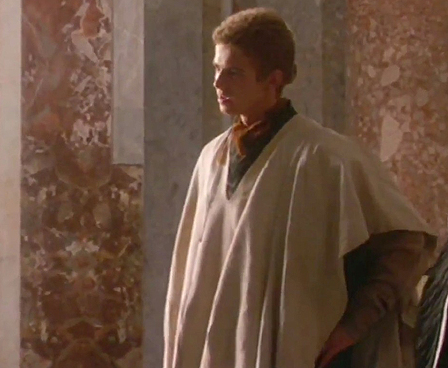
Only here, since Anakin's underlying outfit is brown, it's the poncho itself that is white (instead of the poncho being brown and the outfit beneath white, as in the original concept from the 1970s).
This whole subplot with Padme fleeing Coruscant undercover seems borrowed from the 1974 rough draft. Which is odd, because Lucas had just used that exact plot in TPM.
Some photos from Alexander Nevsky to illustrate its visual influence on the various iterations of SW:
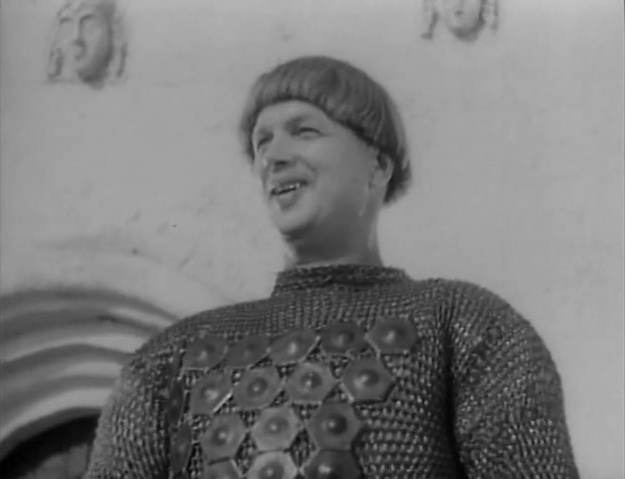
Vasily Buslai, one of the supporting characters, sports the bowl haircut typical of Russian men in this film. Luke Skywalker ended up with a similar haircut.
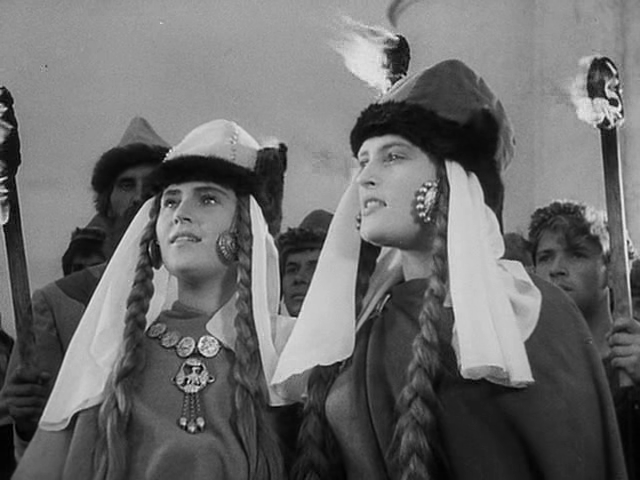
Typical Russian women with their hair braided, much like Kriemhild in Fritz Lang's Die Nibelungen--a hairstyle also intended for Leia Aquilae in the 1974 rough draft.

The film's antagonists, the Teutonic Knights, wear white robes and carry shields, like the white-armored, shield-bearing stormtroopers of Lucas's second draft of SW.
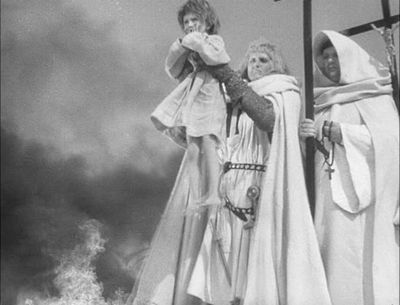
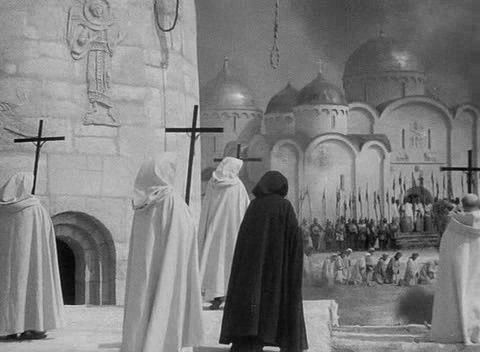
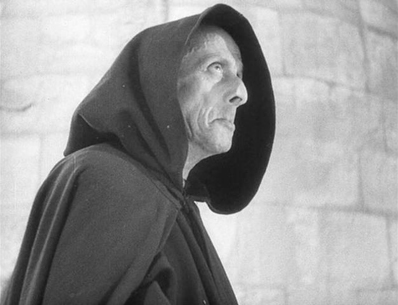
The scenes of white-clad Germans murdering Russian peasants happen under the eyes of a sinister black-robed monk.
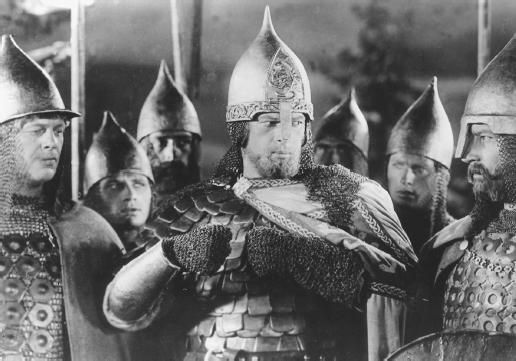
The Russian soldiers (Alexander Nevsky is center in the photo) wear helmets that leave their faces visible, allowing the audience to identify with them.
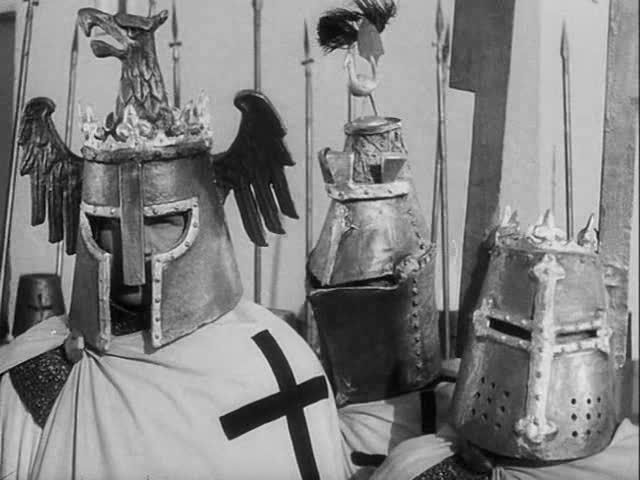
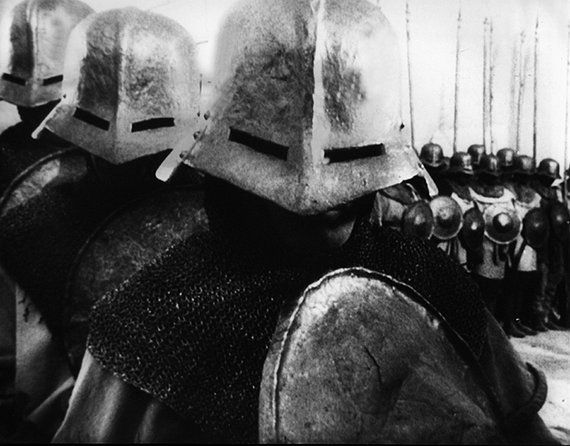
On the other hand, the Germans wear quite Nazi-ish helmets that conceal their faces, making them into a nightmarish Other. Lucas borrowed this idea for the Rebel and Imperial pilot costumes in SW 1977.
Very good catch re: Shadows of the Empire. I hadn't even thought of that, but the Fritz Lang influence is obvious.
---
Alexander Nevsky features the Grand Master of the Teutonic Knights naming one of his order the new Prince of Novgorod--before Novgorod has even been conquered. In Lucas's 1974 rough draft the Emperor does the same for Crispin Hoedaack, the new Governor of Aquilae under Imperial rule.
Eisenstein's striking juxtaposition of black-robed monks and white-robed knights among the German armies also has echoes in both the SW rough draft--where black-armored Imperial troops march down white corridors--and in the final film, which sets the black-clad Darth Vader against white-armored stormtroopers.
And Lucas's rough draft describes the Grande Mouff Tarkin, an Aquilaean priest who wears "long black robes," as contrasted with the white robes of Aquilae's military officers. Here Lucas's use of color symbolism is as deliberately simplistic as elsewhere in the script--more in the vein of Fritz Lang than Eisenstein--because Tarkin is a defeatist who counsels against General Skywalker's plan to save Aquilae from invasion through a pre-emptive strike.
(The priestly origin of this character name explains the derivation of the title Grand Moff: it comes from "Grand Mufti," the chief priest of the Ottoman Empire.)
Plus, the Bene Gesserit in Dune wear black robes, which may have contributed to the black-clad Jedi seen in TPM concept art.
Incidentally, in Fritz Lang's Die Nibelungen, the heroine Kriemhild goes from wearing a white dress in the first film, to wearing mourning black in the second, after her husband Siegfried is killed. This marks her transformation from a youthful, naive innocent to a grieving widow obsessed with vengeance. Lucas surely noted this, though he opted instead to have the rough draft's Leia go through the Madonna-whore transfiguration seen in Lang's Metropolis.
As for Annikin Starkiller's costume, although early on he wears the white uniform of the Aquilaean military, once the group of fugitives set out for Ophuchi with the Princess, he is disguised as a farmer. Likely his farmer outfit would also have been white, making it almost exactly like the costume Mark Hamill wears in the final film.
Because Annikin Starkiller is armed with a laser-sword and laser pistols, he is presumably concealing them. Probably with a brown poncho, reminiscent of Clint Eastwood's Man With No Name:
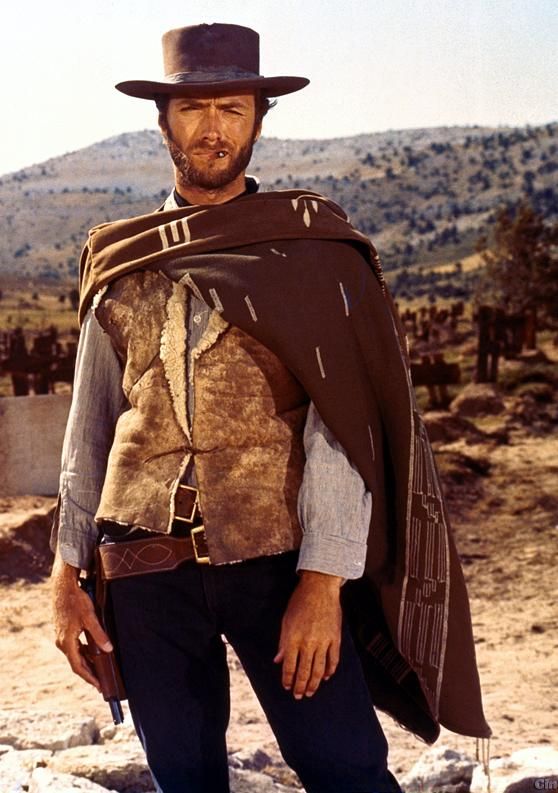
Mark Hamill wore such a poncho over his white outfit in SW 1977, although it hardly shows up in the final film.
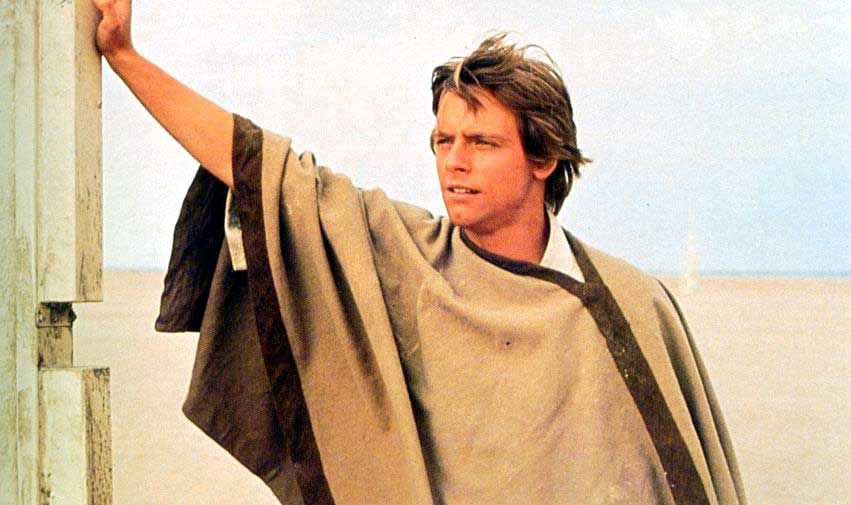
The idea of a white-clad character with a brown Clint Eastwood-inspired poncho would recur in early concept art for ESB. Boba Fett originally had white armor, but his poncho was already brown.
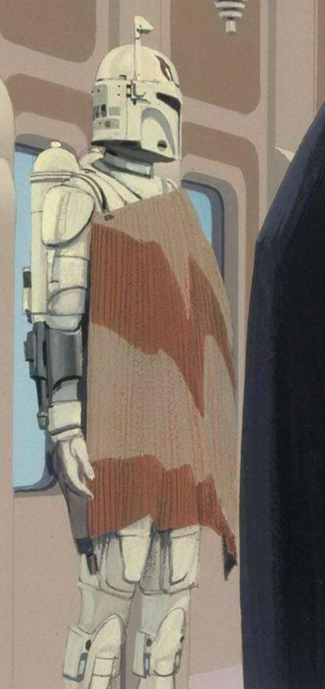
Fritz Lang's Die Nibelungen (1924), parts I and II
The great Fritz Lang's two-part film cycle about the famous German legend of Siegfried the dragon-slayer and his wife Kriemhild. Quite enjoyable if you like silent films in the vein of Metropolis.
The films are pretty damn faithful to the source material, the medieval epic poem The Nibelungenlied. However, they're also full of Lang's trademark striking visuals. There's some unusual symbolism, too--for instance, Lang uses trees throughout both movies as a symbol of death.
Clearly this film duology was an influence on the young George Lucas. And also Tim Burton: Danny Elfman's Batman theme is quite obviously taken from Gottfried Huppertz's musical motif representing Attila the Hun.
7 out of 10 severed heads.
Sergei Eisenstein's Alexander Nevsky (1938)
Despite being a Soviet propaganda piece, this is a wonderfully paced, fast-moving, fun film in the vein of the original Star Wars. The heroes are heroes and the villains are villains, and we know exactly who is who and so rejoice in the heroes' victory.
9 out of 10 horned helmets.
There's one other thing that Lucas probably borrowed from Alexander Nevsky: in Eisenstein's film the heroic Russian soldiers wear helmets that leave their faces visible, but the helmets of the Teutonic Knights conceal their faces entirely.
This is mirrored exactly by the helmets of the Rebel and Imperial pilots during the Death Star trench run--the Rebel pilots have their faces visible and the Imperial pilots do not.
Another film that likely inspired some of the visuals of SW 1977 is Sergei Eisenstein's Alexander Nevsky from 1938.
In that film the main villains are the Teutonic Knights, the vanguard of a German army that is invading Russia. The plot of the film concerns Russian prince Alexander Nevsky's repulsion of the German advance. The movie's climactic battle occurs on a frozen lake, so it's rather reminiscent of the Battle of Hoth in ESB.
The Teutonic Knights are dressed in white robes, and carry shields and broadswords. They were likely the inspiration for the white-armored stormtroopers of the 1975 second draft, who also carry shields and laser-swords.
Also, in one scene, the white-clad knights and white-robed German priests lynch old men and women, and throw babies onto bonfires. This orgy of violence is orchestrated by a black-robed monk.
The contrast of white and black robes among the villains is reminiscent of the appearance of Darth Vader, surrounded by his legions of stormtroopers, in the opening of SW 1977.
Prince Alexander's strategy for defending the town of Novgorod against the Germans is as follows: "I know nothing of defense. We'll attack instead!" This is exactly General Skywalker's strategy for defending Aquilae in the 1974 rough draft.
The ruler of Novgorod is referred to as "Lord Novgorod," which is similar to how Leia Aquilae is the princess of the planet Aquilae in the rough draft.
The Russian men all have bowl haircuts, much like the hairstyle Luke Skywalker sports in SW 1977. The women all wear their hair in two long braids, like Kriemhild in Fritz Lang's Die Nibelungen (and presumably Leia Aquilae in the 1974 rough draft).
Finally, I don't know whether this was the case in the version Lucas saw, but when I watched the film, the subtitles were extremely archaic, with lots of subject-verb inversion. I wonder if this film's dialogue wasn't the inspiration for Yoda's speech pattern.
FanFiltration said:
Underrated films that I enjoy as much as (and sometimes more then) the original. All of these films got some bad press, and disappointed a fair amount of moviegoers'.
The Exorcist III
The Two Jakes
The Trial of Billy Jack
2010 The Year We Make Contact
More American Graffiti
French Connection II
The Four Musketeers*
*did not get bad reviews, but did cause a great deal of controversy.
Fun fact: the guy who plays Cindy Williams' brother in More American Graffiti (Will Seltzer) was the runner-up for the role of Luke Skywalker.
On topic: totally agree with Star Trek III being underrated.
I think a Gray Jedi costume should just be a cosplay of Kyle Katarn. ;)
A bit more on Darth Vader as conceived in Oedipal terms: Freud stated that the Oedipus complex--the desire of the son to supplant the father--is connected to castration anxiety, the fear that the father will emasculate the son. Lucas has openly acknowledged that Luke's loss of a hand in his ESB duel with Vader was conceived as a symbolic castration scene.
It's interesting how all the Freudian imagery in the rough drafts of SW 1977 is connected with Princess Leia, whereas in the later films it revolves around Luke's father.
This dovetails with the fact that in the first film, Luke was meant to end up romantically linked with the Princess--whereas the subsequent films abandoned this and focused on Luke's discovery of his parentage, an idea not present in 1977.
---
One thing in my initial post may actually be incorrect: the rough-draft Princess Leia's "long auburn hair tied in braids" was likely not yet based on the "buns" of Queen Fria from Flash Gordon.
Instead, Lucas may have had in mind the long twin braids of Princess Kriemhild from Fritz Lang's 1924 film Die Nibelungen.
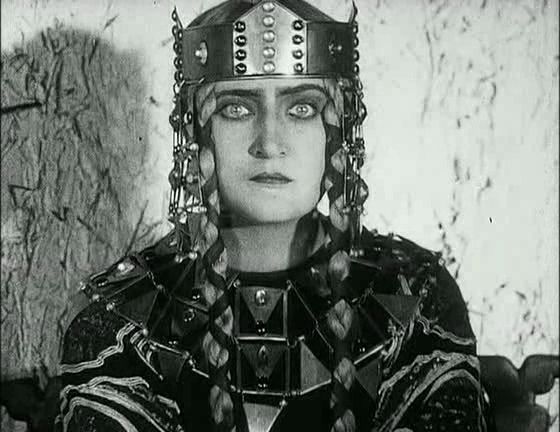
Die Nibelungen is an adaptation in two parts of the medieval German epic poem known as the Nibelungenlied, which tells the story of Siegfried the dragon-slayer. Lang made it around the same time he made Metropolis, and like that film, Die Nibelungen is jam-packed with arresting visuals.
We know that Lucas was quite interested in Fritz Lang's early work: he borrowed from Metropolis not only the likeness of its robot for C-3PO, but also the Whore of Babylon motif for Princess Leia's disarrayed costume.
And we also know that Lucas was reading up on Norse mythology: he considered naming a planet after Brynhild the Valkyrie, a character in Siegfried's story, and Luke Skywalker's name comes straight from "Loki Sky-walker." So Lang's Die Nibelungen would have appealed to him on both counts.
In fact, the very name of the rough-draft hero, "Annikin Starkiller," may have been designed to evoke that of Siegfried/Sigurd, who slew the dragon Fafnir and was known thereafter as "Sigurd Fafnir's-bane."
(The Anakim were a race of giants from the Old Testament, so presumably Annikin's first name is meant to suggest strength and large stature, akin to that of the mythic Siegfried. However, the exact spelling used by Lucas at this time recalls the name of director Ken Annakin.)
Kriemhild is Siegfried's love interest in Die Nibelungen, so it would be fitting for Lucas to borrow her hairstyle for his princess character.
The probability of this connection is enhanced by other visual borrowings from Die Nibelungen which show up elsewhere in Lucas's work.
Take a look at Fritz Lang's Etzel, the barbarian king of the Huns:
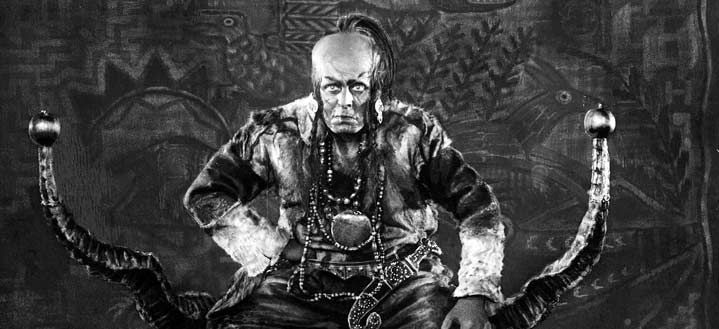
Etzel's hairstyle is significant: it features a shaved head with a topknot and two long front locks.
The shaved head with topknot would recur in Moebius's concept art for Sorsha in Willow (a style recycled for TPM on Aurra Sing).
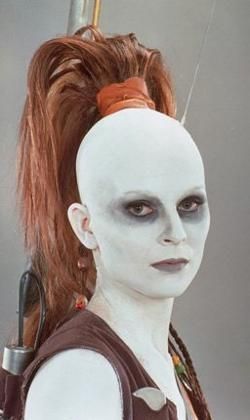
The shaved head and forelocks, on the other hand, would show up with the locks braided (recalling Kriemhild's hairstyle) in concept art for Obi-Wan's hairdo in TPM. (In the final film only one of the braids was used.)
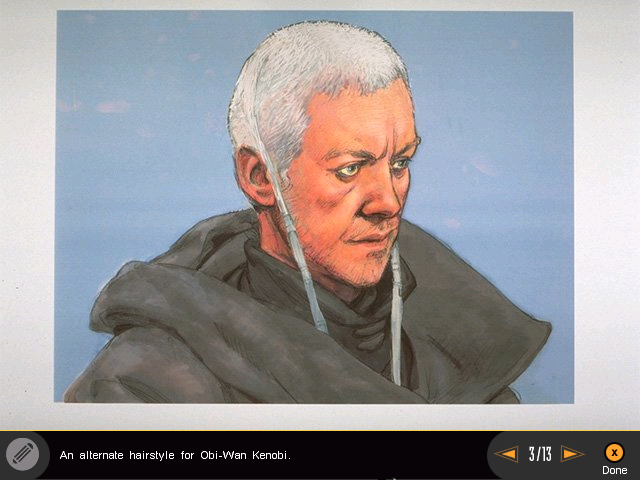
Another of Lang's potent images in Die Nibelungen involves a connection between trees and death.
When Siegfried bathes in the blood of the dragon Fafnir, rendering him invulnerable, a leaf from a tree falls on his back, leaving one spot unmarked and thus open to attack. Later Siegfried finds the evil dwarf Alberich and slays him; in front of Alberich's cave there is a large tree.
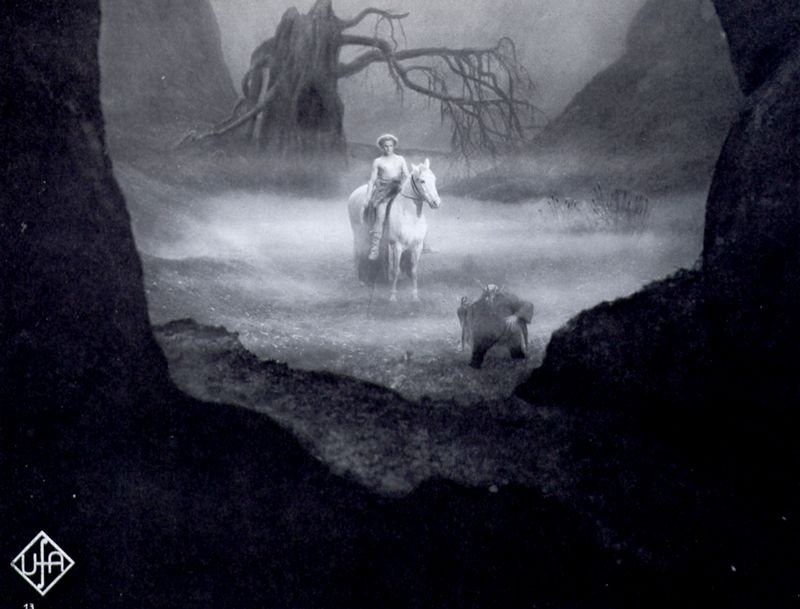
When Siegfried makes a vow of blood-brotherhood with the Burgundian warriors Gunther and Hagen, who will eventually betray and murder him, they pledge their oaths in front of a tree. And when Siegfried dies, Kriemhild has a vision of a tree turning into a skull.
This motif would be reused in the script for ESB, in which a tree was placed at the opening of the sinister cave on Dagobah where Luke has a vision of Darth Vader.
The idea also apparently recurred in early concepts for Willow, where a magical tree with an interior of solid gold (an idea taken from the concealed gold in The Hidden Fortress) was located at the entrance to a dragon's cave.
Also, the whole idea with Leia being Luke's identical "other half" is clearly a visual and symbolic play on the Jungian idea of the anima/animus--respectively, the latent "female" portion of a man's psyche and the "male" part of a woman's.
In Jungian psychology, attaining a healthy relationship with this buried "opposite" part of one's personality is a critical part of becoming a well-adjusted person.
Fitting with the gender inversion associated with Jung's anima/animus, the third draft's Luke Starkiller is naive and idealistic in ways that can easily be construed as feminine, whereas the strong-willed Princess Leia gets roughed up in a fashion befitting Clint Eastwood or Toshiro Mifune. The male lead is girlish and the female lead is a tomboy.
(This idea likely also explains Luke's shaggy haircut--in the second draft he had Flash Gordon-esque short hair.)
And in the rough draft, Leia's gang-rape is the catalyst for a symbolic and visual descent from Madonna to whore--a pervasive dichotomy concerning women in Western thought, famously identified by Sigmund Freud.
Obviously Lucas was reading up on Freudian and Jungian psychology from very early on, in an effort to invest his space film with some archetypal symbolism. Darth Vader as Oedipus complex, anyone?
Some other additional musings:
The idea from the third draft that Princess Leia would look exactly like Luke, so as to communicate visually that they are two halves of one being and thus soul mates, may actually explain why Lucas didn't have Luke "get the girl" in the later films.
When Lucas cast Carrie Fisher as Leia, it was obviously not for physical resemblance to the blond Mark Hamill. As a brunette, Fisher better resembles the black-haired Leia (based upon Dale Arden from Flash Gordon) seen in Alex Tavoularis' storyboards. Consequently, she likely didn't fit the mold for Lucas's mental picture of Luke's girlfriend (i.e., a mirror image of him).
As a result of this dissonance, I would guess, in the second film Lucas decided to pair up Leia and Han, instead of having her get together with Luke as envisioned during SW 1977. Luke, meanwhile, would be associated with a girl who looked exactly like him, as per the idea from the original film.
However, since it would be extremely silly to just drop in another Princess as Luke's girlfriend, Lucas decided instead to make this new female character Luke's lost twin sister--taking the already-intended physical resemblance and running with it.
The plot thread of Luke's lost sister was meant to be fleshed out in the films following ESB--including the Sequel Trilogy as it was then imagined.
But after the exhaustion that overseeing the making of ESB led him to, Lucas decided to wrap things up with just one more film. The resulting compressed storyline meant that he had to find a way to introduce Luke's sister quickly.
He settled for making the lost sister be Leia--bringing his initial idea for Luke's "other half" full circle. Of course, this meant dropping the earlier intended notion of a marked physical resemblance entirely.
---
On another note, poor Leia in the third draft actually ends up being the recipient of Vader's partial Force choke (used on Admiral Motti in the final film).
And later in the third draft script it's implied that Vader and two Imperial officers are the ones who physically beat her up, leaving her unconscious and bloody when the heroes break open her prison cell.
Paired with the Father Vader and Sister Leia retcons, that would have made for even more awkward viewing than the torture droid scene in the final film.
You guys are likely right that a film version of the 1974 SW rough draft would have been a box office flop (even if it did wind up becoming a cult classic later on).
The real problem with this draft is the characterization, or lack thereof. For instance, Annikin Starkiller has too much of Conan the Barbarian and Toshiro Mifune in him to be anywhere near as likeable as the wide-eyed naivete of Mark Hamill is in the final film.
But also, the rough draft as written would surely have been quite expensive to produce. If the film flopped in general release it likely wouldn't have made its money back.
Combined with the earlier box-office failure of THX 1138, filming this draft might have killed Lucas's film career before it really ever took off.
But in that case we wouldn't have Raiders of the Lost Ark. So I think overall the actual state of affairs is a net win.
Aside from George Lucas, I blame Robert Zemeckis and Bob Gale. If it hadn't been for that completely crazy first draft of Back to the Future Indy wouldn't have been taking any nuclear joyrides in airborne fridges.
"Padawan" is one of those SW terms, like "Sith," that's been around for ages and ages (specifically, since the 1974 rough draft) even though it's never actually mentioned in the OT.
Which probably means that somebody must have suggested to Lucas at one point that it sounded a bit silly. Rather like the story about Brian de Palma comparing "the Force of Others" (as it was called at the time) to "the Farts of Others." And Lucas, not yet having risen to a position where no one could tell him 'no,' acquiesced--for the moment.
Some of the planet names in the rough draft of SW are clearly indebted to real-life stars and constellations, as well as literature and mythology.
Princess Leia's home planet, the desert planet Aquilae, has a name with three syllables that begins with the letter A, like Frank Herbert's Arrakis. However, it also evokes the name of Aquilonia, the kingdom ruled by Conan the Barbarian in Robert E. Howard's stories. The form of the name itself comes from the real-world constellation Aquila, the Eagle.
Interestingly, the brightest star in Aquila (which, in astronomical terms, is catalogued as Alpha Aquilae) is Altair. Altair IV was the desert planet featured in Forbidden Planet. The numeral recurs in SW with the "forbidden planet" of Yavin IV.
In Dune, House Harkonnen's home planet, Giedi Prime, was said to orbit the star 36 Ophiuchi B. This resulted in Ophuchi (with one letter removed) becoming the name of the planet of "the chrome companies" in the rough draft.
Alderaan, at this stage the name of the capital city of the Empire, derives from the real-world star names Aldebaran (Alpha Tauri) and Alderamin (Alpha Cephei).
Additionally, in notes for the Journal of the Whills outline, Lucas considered naming Aquilae Yoshiro (after Toshiro Mifune). Alderaan also had an alternate name: Brunhuld (after Brynhild the Valkyrie, girlfriend of Sigurd the dragon-slayer in Norse mythology).
The two races on Aquilae/Yoshiro were to be the Bebers (the humans) and "the Hubble people," a species of green-skinned aliens much like Edgar Rice Burroughs' Green Martians. The name Hubble derives from astronomer Edwin Hubble.
Clearly Lucas was researching Norse mythology at this early stage, because the Journal of the Whills outline features a ship named Balmung (named after Siegfried's sword in the Nibelungenlied, a German variant of the story of the Norse hero Sigurd).
Moreover, Sigurd inherits his sword as a young man from his deceased father Sigmund, and uses it to kill the dragon Fafnir--an idea that very obviously had an impact on Lucas' finished film of 1977.
Incidentally, in the 1974 rough draft Annikin Starkiller apparently has black hair, and Princess Leia is a redhead. In the Dune series Paul Atreides has black hair, and his girlfriend Chani has red hair, which she passes on to their twin children.
On the other hand, the Ralph McQuarrie drawings of Luke and Leia from the third draft, where they're both blondes, are more reminiscent of the original 1936 Flash Gordon serial.
In his first screen outing Flash kept his blond hair from the comics page, but his normally brunette girlfriend Dale Arden was transformed into a blonde herself, in an attempt to capitalize on the popularity of Jean Harlow. (Dale regained her usual dark hair in the later Flash Gordon serials.)
Jean Harlow herself frequently dressed all in white, like Leia in SW.
As well, with the third draft's Han Solo having the brown hair of Buck Rogers, a blonde Princess Leia would also bear a resemblance to the yellow-haired Wilma Deering of the Buck Rogers comic strip.
Han's rough-draft counterpart, Clieg Whitsun, is blond like Flash Gordon. Since Lucas likely already intended to suggest a love triangle here, the relationship between Clieg and the rough draft's Princess Leia would be visually analogous to that of Flash Gordon and the red-headed Princess Aura, daughter of Ming the Merciless. Of course, much like Flash and Aura, Clieg and Leia aren't meant to end up together.
Also, the Metropolis parallels don't stop with the SW rough draft. Consider that Joh Fredersen is the villainous father of the principal hero, Freder, and that Fredersen the elder ends up being redeemed at the end of the film. I think that Fritz Lang's film was very much on Lucas's mind when he finally decided that Darth Vader was Luke's father.
Which also makes me wonder--could we make another link, between the evil mad scientist Rotwang (who always dresses in black, and whose house is decorated with occult pentagrams) and the sorcerous Emperor of ROTJ?
Of course, the Force lightning that Palpatine shocks Luke with in ROTJ is another idea derived from the 1974 rough draft, namely from the electric torture General Darth Vader uses on Leia Aquilae. (Poor Leia. Between this, losing both her parents, and the heavily implied offscreen gang-rape, she's clearly the victim of a conga-line of trauma.)
Raiders of the Lost Ark
The Mummy
The Mummy II
The Mummy: Tomb of the Dragon Emperor
One other thing, mentioned solely because it disturbs me greatly and I can't unthink it: looking back over the rough draft, I noticed there are nine trappers mentioned in the scene where Starkiller goes on his murderous rampage, of whom he kills eight. Afterwards Leia is dressed like Fritz Lang's Whore of Babylon for the remainder of the film.
And in The Hidden Fortress, before they're prevented from acting out their desires, Matashichi and Tahei agree to take turns having their way with the Princess. Do the math. And pass the brain bleach, please.
In Lucas' rough draft script there is a constant theme of the intertwining of the heroic and the monstrous. Figures from earlier films who were once deemed monsters now become Lucas's heroes.
R2-D2 is a Wellsian Martian tripod; C-3PO is the robot from Metropolis; Han Solo is the Creature from the Black Lagoon; Chewbacca is King Kong.
Prince Valorum is a Black Knight and a traitor to his Imperial masters. Annikin Starkiller is a wild and fierce warrior in the vein of Conan the Barbarian, an unstoppable force of bloodshed when roused to anger. And even Princess Leia is represented as the Whore of Babylon.
What gives?
Likely Lucas had in mind the original Japanese title of The Hidden Fortress. As famed Kurosawa scholar Donald Richie points out in a book Lucas owned, the title in Japan is actually Three Bad Men in a Hidden Fortress.
The "three bad men" are the two peasants, Tahei and Matashichi, and the Princess's protector, General Rokurota Makabe (played by Toshiro Mifune). The peasants are obviously "bad," for they are both cowards who complain when put to work, and they argue with each other constantly. They would gladly ravish the Princess and steal her gold in a heartbeat--if only they could agree how to divvy the gold up.
But General Makabe is bad too. He is bad, Richie argues, because he is so consumed by his devotion to his duty--serving the Princess--that he has lost all human feeling. He turns his own teenage sister in to the authorities hunting for the fugitive Princess Yuki, lettting her be executed as a decoy to throw the enemy off the trail of the real Princess.
This is arguably also the failing of General Skywalker, the Rokurota Makabe character, in Lucas' rough draft. Skywalker doesn't even blink when Leia's mother and her entourage commit suicide via nuclear blast.
Apparently Lucas felt that, in keeping with the spirit of Kurosawa's film, each of the other heroes he added to the plot should be "bad" in his or her own way too. In some cases this extends only to outer appearances, but in others (Annikin Starkiller, for instance) the descriptor is quite apt.
Come to think of it, there's a lot more visual symbolism borrowed from Fritz Lang's Metropolis in the rough draft than I initially realized.
The protagonist of Lang's film is Freder, a young man born to privilege who yearns for a more fulfilling life. Like the rough draft's Annikin Starkiller, and the final film's Luke Skywalker, Freder always wears white.
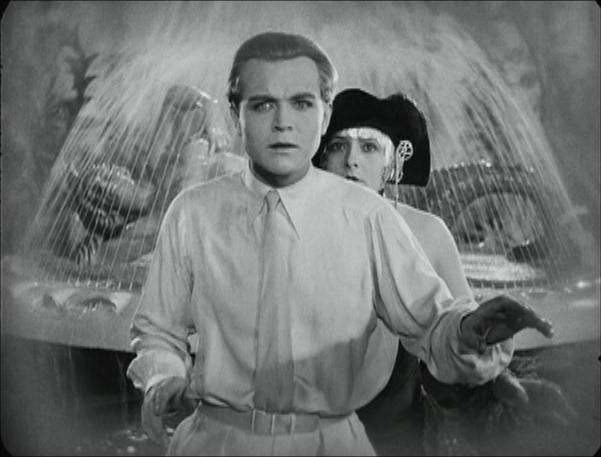
Freder's love interest is Maria, a beautiful girl who makes clandestine visits to the underground city of the laboring classes, where she preaches a gospel of social justice and equality.
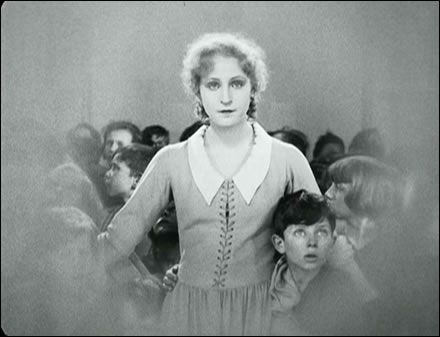
As per her name and her light-colored clothing, Maria is obviously a Virgin Mary figure.
Freder's father, Joh Fredersen, is the leader of Metropolis. Fredersen fears that Maria's preaching could lead to a rebellion of the working classes against bourgeois rule, destroying his shining city forever.
Accordingly, Fredersen enlists the mad scientist Rotwang to make his "Machine-Man" (the film's famous robot) into an exact likeness of Maria, a duplicate who will engage in depraved and profane acts and so destroy her base of support among the pious poor.
Rotwang kidnaps Maria and takes her to his laboratory, where he hooks her up to his machines, infusing his robot with her visage. Maria is glimpsed naked; the scene is a symbolic rape. Freder, meanwhile, searches for his missing girlfriend, but is unable to penetrate Rotwang's inner sanctum, and sits helplessly on the doorstep outside as Rotwang works his devilry.
With the real Maria safely imprisoned, the False Maria robot takes her place. False Maria quickly establishes herself as a Whore of Babylon figure, attending the parties of rich aristocrats clad only in a white skirt and a couple of pasties.
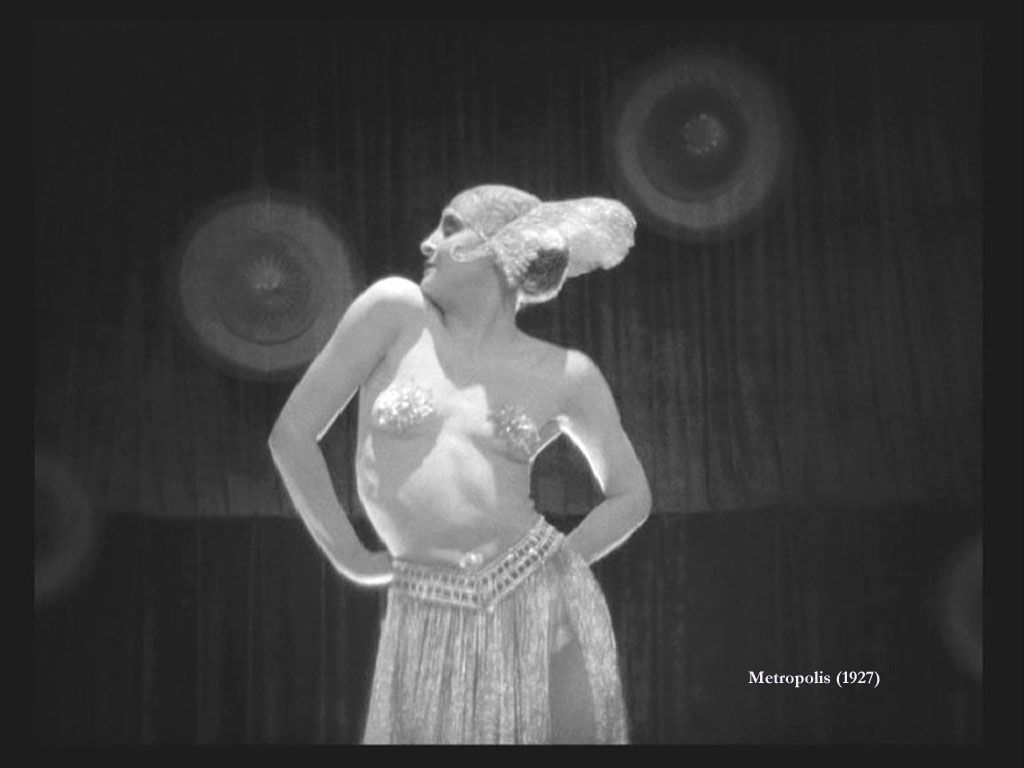
Of course everything eventually turns out well again in the end. Maria escapes from captivity; Joh Fredersen realizes the error of his ways and turns against Rotwang; Freder and Rotwang fight on the rooftop of a cathedral, and Rotwang plunges to his doom.
In the finale Joh Fredersen pledges to improve the lot of the workers beneath Metropolis. His newfound purity of heart is symbolized by his hair, which has turned white after watching his son battle Rotwang on the perilous cathedral roof.
Obviously quite a lot of the visual symbolism of Metropolis recurs in Lucas's rough draft. A hero clad all in white; a heroine represented as the Virgin Mary; the rape of the heroine; her subsequent transformation into a bare-breasted Whore of Babylon figure.
Of course, Lucas couldn't resist the temptation once more to recast an older villainous figure into a new heroic one, as he did many times elsewhere in this draft. Thus the nakedness that in Lang's film was emblematic of the Whore of Babylon becomes for Lucas a representation of the goddess Liberty.
There is one rather alarming subtext in the SW 1974 rough draft that reoccurs elsewhere in Lucas' work, which I haven't mentioned yet. Namely, sexual assault happening to the principal heroine.
The scene in the rough draft where Leia reappears on Yavin, having been stripped by the jungle trappers, raises a disturbing question. Did the trappers rape her? The answer: Very likely yes, but it's deliberately never stated outright.
Consider: When Lawrence Kasdan wrote his first pass at the ROTJ script, he included a scene where the captured Leia asks Threepio what fate Jabba will deal out to her. "Death?" Threepio responds: "Worse." Kasdan is alluding here to the phrase "a fate worse than death," the old euphemism for rape. So this is basically an in-your-face announcement that Leia is about to be sexually assaulted.
That was undoubtedly too explicit for Lucas to countenance. So instead, when Lucas revised Kasdan's script himself, he changed the dialogue here. Now Leia tells Lando, "I'll be all right." Lando responds, "I'm not so sure."
With this new dialogue, Lucas creates ambiguity. Is Leia in danger or not? The intent, of course, is to play to two different audiences. Kids will think only of mortal danger, and not grasp the subtext of the scene. Adults, however, will understand exactly what is being implied here. The dark implications of the Jabba scenes have not changed--only the extent of their verbalized expression on screen.
In a similar vein, nothing in the SW rough draft is ever explicitly said about how far the trappers got with Leia Aquilae before Annikin interrupted them. However, they clearly had time to knock her unconscious, drag her off and strip her. They may have done more, or not; the details are left to the audience to fill in for themselves.
In The Hidden Fortress, there is a scene where the slave girl whom Princess Yuki bought and freed earlier in the film repays the favor, by preventing Yuki from being raped as she sleeps by the bickering peasants, Matashichi and Tahei.
However, in this instance Lucas has chosen to deviate somewhat from the model of Kurosawa. Instead he portrays Annikin Starkiller as avenging Leia's pain and dishonor, cutting down the trappers in a frenzied rage.
This point in the original script is therefore clearly also the genesis of the scene in AOTC where Anakin Skywalker finds his dying mother in the camp of the Sand People, then proceeds to slaughter all the Tusken Raiders in the camp. As with Leia in the 1974 rough draft, it's heavily implied that Shmi has been sexually abused.
Given that a rape scene transforms Leia Aquilae from a robed virginal Marian figure into a bare-breasted goddess of Liberty, one could probably write a whole dissertation on the Madonna/whore complex as Leia embodies it in this rough draft.
I suspect this rather distasteful element is actually another marker of the influence of Robert E. Howard's Conan stories on young Lucas. In Howard's stories Conan's love interests are frequently slave girls whom he liberates from their former masters. Invariably the narrative dwells on these women's loss of their "virtue" to their captors--never naming rape explicitly, but always implying it. Both Lucas' casual suggestion of rape and the coy manner in which he handles it are highly reminiscent of Howard's writing.
The influence of Conan on Lucas' portrayal of female sexuality may also explain the idea, suggested in Raiders of the Lost Ark, that Marion Ravenwood worked as a prostitute in a Nepalese brothel. Once again Kasdan wrote dialogue explicitly confirming this, and once again it was too frank to make the final cut.
The engine splits--or rather, it's actually two semicircular engines--because that's how it worked in Ralph McQuarrie's paintings of X-wings. That detail was changed for the final models into two separate circular engines. It's something that's always stood out for me when I look at the McQuarrie paintings of the Death Star battle.
I think that instead the article is probably referring to Luke's second lightsaber, the one he built himself. Which would mean somebody severed his hand again.
If this rumor is anywhere near true, it means we'll likely see Luke outfitted with a far more rough-and-ready prosthesis later in the film--if the apparent Mad Max aesthetic of the new trilogy is anything to go by.
Of course, the OT Storyboards book revealed that the idea of Luke losing his mechanical right hand was already thought up back during ROTJ.